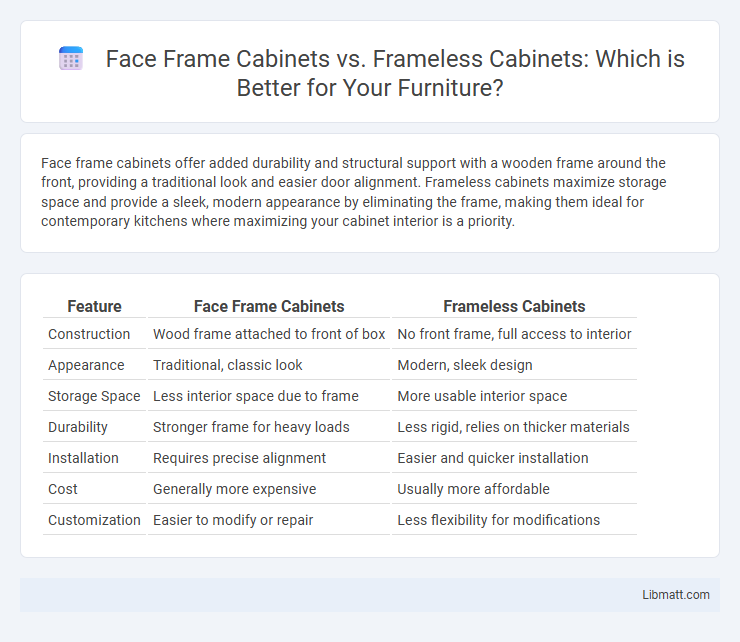Face frame cabinets offer added durability and structural support with a wooden frame around the front, providing a traditional look and easier door alignment. Frameless cabinets maximize storage space and provide a sleek, modern appearance by eliminating the frame, making them ideal for contemporary kitchens where maximizing your cabinet interior is a priority.
Table of Comparison
| Feature | Face Frame Cabinets | Frameless Cabinets |
|---|---|---|
| Construction | Wood frame attached to front of box | No front frame, full access to interior |
| Appearance | Traditional, classic look | Modern, sleek design |
| Storage Space | Less interior space due to frame | More usable interior space |
| Durability | Stronger frame for heavy loads | Less rigid, relies on thicker materials |
| Installation | Requires precise alignment | Easier and quicker installation |
| Cost | Generally more expensive | Usually more affordable |
| Customization | Easier to modify or repair | Less flexibility for modifications |
Introduction to Face Frame and Frameless Cabinets
Face frame cabinets feature a sturdy frame of hardwood surrounding the front edges, providing extra strength and traditional styling, while frameless cabinets, also known as European-style cabinets, maximize interior storage space with a full-access design and sleek, modern appearance. Choosing between these two styles affects your kitchen's durability, accessibility, and aesthetic, with face frame cabinets offering reinforced structure and frameless cabinets delivering a seamless look. Understanding these key differences helps you select the cabinet type that best suits your functional needs and design preferences.
Key Design Differences Between Face Frame and Frameless Cabinets
Face frame cabinets feature a sturdy wooden frame around the front opening, providing enhanced structural support and a classic design aesthetic, while frameless cabinets lack this frame, offering a sleek, modern look with increased interior space and easier access. The face frame design typically results in visible borders around cabinet doors and drawers, whereas frameless cabinets allow for full overlay doors that create a seamless exterior. Frameless cabinets rely on thicker side panels for stability, contrasting with the thinner side panels of face frame cabinets supported by the front frame.
Construction Methods: Face Frame vs Frameless Cabinets
Face frame cabinets feature a wooden frame attached to the front edges of the box, providing added strength and alignment for doors and drawers while enabling easier door mounting and adjustments. Frameless cabinets, also known as European-style cabinets, omit the front frame, maximizing interior space and offering a sleek, modern appearance with full access to cabinet contents. The construction of face frame cabinets typically involves mortise-and-tenon joints for durability, whereas frameless cabinets rely on thicker, high-quality plywood or MDF panels bonded with edge banding for structural integrity.
Pros and Cons of Face Frame Cabinets
Face frame cabinets offer superior structural support and durability, making them resistant to warping and ideal for heavy use in kitchens or workshops. They provide a classic, finished look with visible frames that enhance door alignment and ease of installation but can reduce accessible cabinet opening space compared to frameless designs. Your choice may depend on prioritizing traditional aesthetics and robustness over maximized storage capacity.
Pros and Cons of Frameless Cabinets
Frameless cabinets offer a sleek, modern appearance with increased accessibility and easier installation due to the absence of a frame, making full use of the interior space. They provide a minimalist aesthetic and often feature thicker cabinet walls for enhanced durability but can be more susceptible to misalignment over time compared to face frame cabinets. Their clean lines and seamless surfaces are ideal for contemporary kitchens, though the lack of a frame may reduce support for heavy adjustable shelves and hardware.
Storage and Accessibility Comparison
Face frame cabinets offer enhanced structural support, making shelves more durable and capable of holding heavier items, which maximizes storage efficiency. Frameless cabinets provide greater accessibility with a wider opening, allowing easier reach into corners and better use of interior space. Your choice depends on whether you prioritize robust storage capacity or seamless accessibility for everyday use.
Aesthetic Appeal: Traditional vs Modern Cabinet Styles
Face frame cabinets offer a traditional aesthetic with visible wood frames that enhance durability and add classic charm to your kitchen. Frameless cabinets feature sleek, flat surfaces creating a modern, minimalist look that maximizes storage space and provides clean lines. Choosing between these styles depends on your preference for either timeless warmth or contemporary simplicity in your cabinetry design.
Durability and Strength Considerations
Face frame cabinets provide enhanced durability and strength due to their solid wood frame construction, which reinforces the cabinet structure and resists sagging over time. Frameless cabinets, while offering a sleeker, modern appearance, rely on thicker plywood or MDF panels for support, making them less sturdy under heavy loads but easier to access inside. Your choice between the two should consider the need for robust, long-lasting cabinetry versus maximizing interior space and a minimalist look.
Cost Differences: Face Frame vs Frameless Cabinets
Face frame cabinets typically cost more due to additional materials and labor involved in constructing the frame. Frameless cabinets, also known as European-style cabinets, offer a more cost-effective option because of streamlined manufacturing and easier installation. Your choice between face frame and frameless cabinetry will impact budget considerations, with frameless designs often providing savings without sacrificing durability.
Choosing the Right Cabinet Type for Your Kitchen
Face frame cabinets offer enhanced durability and traditional aesthetics with a visible frame that supports door hinges and provides structural integrity. Frameless cabinets maximize storage space and create a sleek, modern look by eliminating the face frame, making them ideal for contemporary kitchen designs. When choosing the right cabinet type for your kitchen, consider your style preference, storage needs, and appliance compatibility to ensure functionality and visual appeal fit your lifestyle.
Face Frame vs Frameless Cabinets Infographic

 libmatt.com
libmatt.com